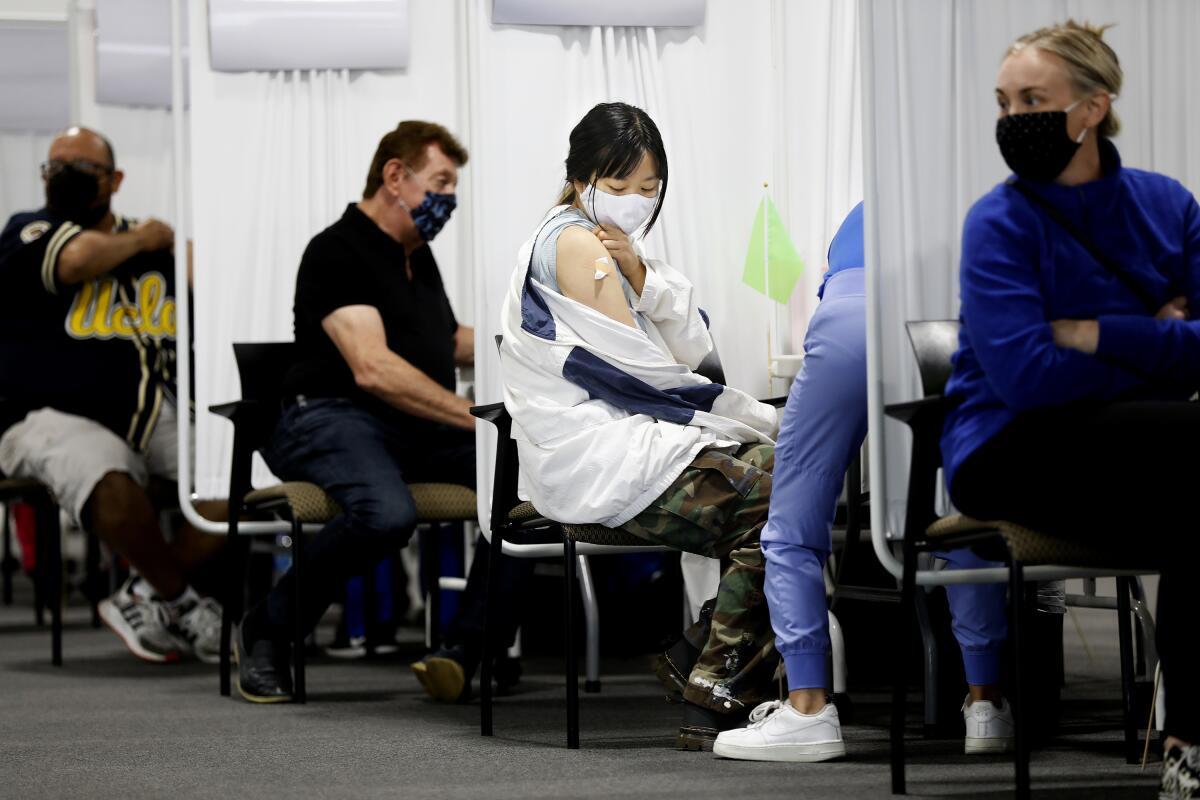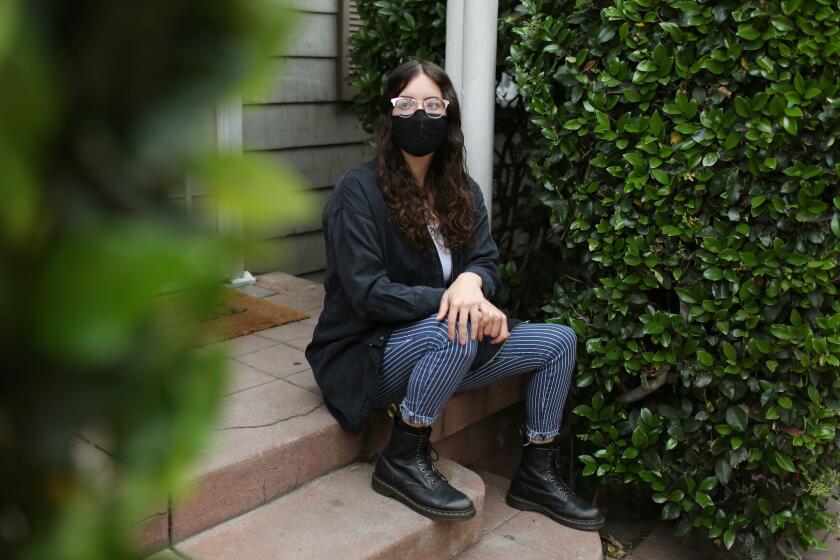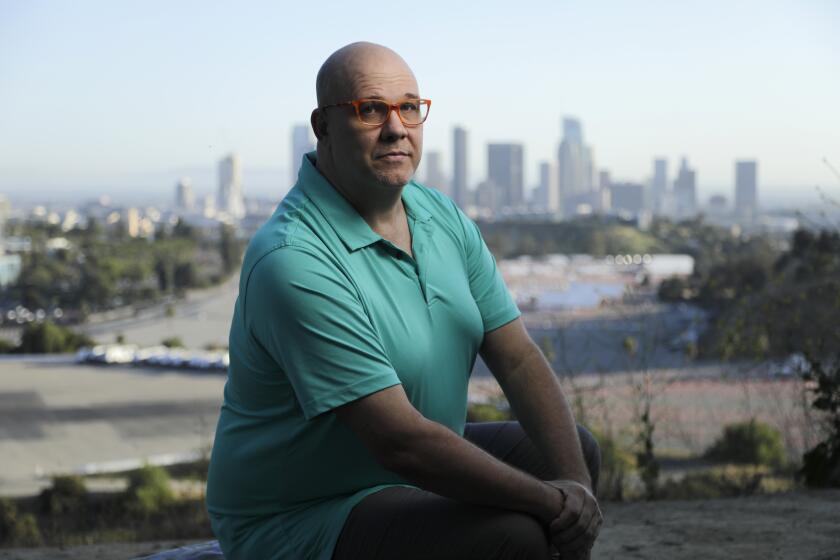Vaccinating children, vigilance next phase of California’s COVID-19 battle

- Share via
SAN FRANCISCO — California continues to see dramatic progress in the fight against COVID-19, with very low recorded infection rates and vaccine distribution continuing to move forward. New cases and deaths have plummeted since the fall and winter surge.
All this has allowed wide swaths of the economy to reopen.
Despite these gains, though, experts think that herd immunity is still a ways off. They say several factors will keep COVID-19 a fact of life for some time: Some people are unwilling to get vaccinated, and younger children have not been part of the immunization efforts.
Here is what we know:
Will herd immunity ever come?
There are some estimates that 70% to 85% of a population must be inoculated to have immunity at sufficient levels to interrupt the spread of the coronavirus across a community.
But getting there may be hard. A poll conducted by the Kaiser Family Foundation found that about 20% of Americans say they either will definitely not get the vaccine or would only if required.
Certain segments of the population are even less likely to get the vaccine. The Kaiser Family Foundation poll found that in March, 35% of surveyed Republicans said they will “definitely not” get the vaccine or would get it only if required. Among rural residents, 30% said the same.
There is a potential for outbreaks if enough people are not vaccinated.
We seem to be on the cusp of returning to normal life, but for many people, transitioning back to Before Times is proving to be a lot more fraught than we expected.
Also, roughly 50 million people in the U.S. are children under the age of 12. Vaccinating this group may not start until early 2022.
“Those two groups alone mean that we probably will not be able to approach true herd immunity by the end of the year — unless people dramatically change in terms of their willingness to take [the] vaccine,” or that vaccinations are permitted to be expanded more rapidly to younger children, said Dr. Robert Kim-Farley, medical epidemiologist and infectious diseases expert at the UCLA Fielding School of Public Health.
Kim-Farley said he expects we eventually will achieve low levels of disease transmission, but “we probably will not achieve zero, which is what you would hope to achieve with true herd immunity. There’ll be probably, then, isolated outbreaks that would be occurring around the country, especially in any pockets of persons who tend to be vaccine-hesitant, or in groups of young children.”
Vaccine rollout: More ups than downs
Nationwide, there has been much attention on how 54% of U.S. adults have received at least one dose of vaccine; in California, it’s 60%. But when factoring in all residents, including children, only 43% of all residents nationally have received at least one shot. In California, 47% of residents have received at least one dose, according to the U.S. Centers for Disease Control and Prevention.
The L.A. County Department of Health Services estimates that about 63% of L.A. County residents have protection from COVID-19 — about 25% through vaccination and 38% because they’ve survived the disease.
Los Angeles County has made significant strides in administering COVID-19 vaccines in communities of color hardest hit by the pandemic, but those areas continue to lag far behind wealthier neighborhoods and the county as a whole, according to a Times data analysis.
County data released Friday showed that among seniors, roughly 70% of white and Asian American residents and 64% of Native Americans had received at least one. But among Latino and Black seniors, only 55% had received at least one shot.
Among everyone in L.A. County 16 and older, more than 50% of white and Asian American residents and 49% of Native Americans have received at least one dose. Only about 30% of Latino and Black residents had received at least one dose.
Kim-Farley said he expects that parts of the nation will soon begin to see demand for vaccines lessen after most who were eager to get the vaccine have received their shots.
There are concerns nationally that the 10-day pause on administering the Johnson & Johnson vaccine, which was lifted on Friday, has caused some people to hold off on getting vaccinated. Officials have emphasized the risk of blood clots among those receiving that shot is extraordinarily rare: in the general population, fewer than 2 in 1 million people getting the J&J jab could be expected to develop the perplexing clotting disorder.
Neither of the two other vaccines authorized in the U.S., manufactured by Pfizer and Moderna, have had similar reports related to blood clots.
By contrast, the risk of an L.A. County resident dying from COVID-19 has been as much as 1 in 427.
Dozens of grass-roots organizations have formed to make sure that COVID-19 and its lingering symptoms remain in the public eye.
California’s future path
At a panel discussion hosted by the Sacramento Press Club, Dr. Mark Ghaly, the California Health and Human Services secretary, credited the state’s December and January regional stay-at-home order for blunting the pandemic and bringing cases to among the lowest levels since the start of the pandemic.
By October, Ghaly said he expected there would be enough Californians — and Americans — vaccinated that the risk of contracting the virus would be dramatically lower. Until then, he said a number of people will probably prefer dining outdoors at restaurants instead of indoors, keep their social circles small and continue to wear a mask in settings where they’re unsure of others’ vaccination status.
Because vaccines likely will not have been authorized for children by October, “we’re going to still need to protect young people. We’re still going to need to be concerned about the potential transmission because young people, although they don’t become as sick and even as frequently infected ... we still know that they become a vector for transmission.”
But in general, Ghaly said, he expects that by the fall, Californians will return to doing most of the things they were doing before the pandemic, with some COVID-19 mitigations still in place.
However, variants will still be a concern. “This is a sneaky virus that will try to mutate,” Ghaly said, so officials will need to continue testing and disease investigation at a high level to detect any new variants of the virus that have the potential to break through immunity.
Times staff writer Melissa Healy contributed to this report.
More to Read
Sign up for Essential California
The most important California stories and recommendations in your inbox every morning.
You may occasionally receive promotional content from the Los Angeles Times.














